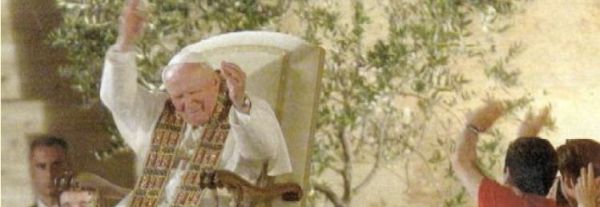1. The "miracles and signs" that Jesus performed to confirm his messianic mission and the coming of the kingdom of God are ordered and closely linked to the call to faith. This call in relation to the miracle has two forms: faith precedes the miracle, indeed it is a condition for it to take place; faith constitutes an effect of the miracle, because it is provoked by it in the souls of those who received it, or witnessed it.
It is well known that faith is man's response to the word of divine revelation. The miracle occurs in organic connection with this revealing word of God. It is a 'sign' of his presence and working, a sign, one might say, that is particularly intense. All this sufficiently explains the special link that exists between the "miracle-signs" of Christ and faith: a link so clearly delineated in the Gospels.
2. There is in fact a long series of texts in the Gospels in which the call to faith appears as an indispensable and systematic coefficient of Christ's miracles.
At the beginning of this series are the pages concerning the Mother of Christ in her behaviour at Cana of Galilee, and before that - and above all - at the moment of the annunciation. One could say that it is precisely here that one finds the culminating point of her adherence to the faith, which will find its confirmation in the words of Elizabeth during the visitation: 'And blessed is she who believed in the fulfilment of the words of the Lord' (Lk 1:45). Yes, Mary believed like no other, being convinced that "nothing is impossible to God" (cf. Lk 1:37).
And at Cana of Galilee her faith anticipated, in a certain sense, the hour of Christ's revelation. Through his intercession, that first miracle-sign took place, thanks to which Jesus' disciples "believed in him" (Jn 2:11). If the Second Vatican Council teaches that Mary constantly precedes the people of God on the paths of faith (cf. Lumen Gentium, 58.63; Ioannis Pauli PP. II, Redemptoris Mater, 5-6), we can say that the first foundation for this assertion is already found in the Gospel, which reports "miracle-signs" in Mary and for Mary in relation to the call to faith.
3. This call is repeated many times. . To the leader of the synagogue, Jairus, who came to ask for his daughter's return to life, Jesus says: "Do not be afraid, only continue to have faith!" (and he says "do not be afraid" because some advised Jairus against turning to Jesus) (Mk 5:36).
When the father of the epileptic asks for the healing of his son, saying: "But if you can anything . . . help us", Jesus replies: "If you can! Everything is possible for those who believe". Then we have the beautiful act of faith in Christ of this tried man: "I believe, help me in my unbelief!" (cf. Mk 9:22-24).
Finally, we recall Jesus' well-known conversation with Martha before the resurrection of Lazarus: "I am the resurrection and the life . . . Do you believe this? . . Yes, O Lord, I believe . . ." (cf. Jn 11:25-27).
4. The same link between the "miracle-sign" and faith is confirmed by other negative facts. Let us recall some of them. In Mark's Gospel we read that Jesus in Nazareth "could perform no miracle, but only laid hands on a few sick people and healed them. And he marvelled at their unbelief" (Mk 6:5-6).
We know the gentle rebuke Jesus once addressed to Peter: "Man of little faith, why did you doubt?". This happened when Peter, who at first went boldly on the waves towards Jesus, then by the violence of the wind became afraid and began to sink" (cf. Mt 14:29-31).
5. Jesus emphasises more than once that the miracle he performed is linked to faith. "Your faith has healed you", he says to the woman who had been suffering from haemorrhaging for twelve years and who, when she came up behind him, touched the hem of his cloak and was healed (cf. Mt 9:20-22; Lk 8:48; Mk 5:34).
Similar words Jesus pronounced while healing blind Bartimaeus, who at the exit from Jericho insistently asked for his help, crying out: "Son of David, Jesus, have mercy on me!" (cf. Mk 10, 46-52). According to Mark: "Go, your faith has saved you", Jesus answers him. And Luke specifies the answer: "Have sight again! Your faith has saved you" (Lk 18:42).
He makes an identical statement to the Samaritan healed of leprosy (Lk 17:19). While to two other blind men pleading to regain their sight, Jesus asks: "Do you believe that I can do this?" "Yes, O Lord!" . "Let it be done to you according to your faith" (Mt 9:28-29).
6. Particularly touching is the episode of the Canaanite woman, who did not cease to ask Jesus' help for her daughter "cruelly tormented by a demon". When the Canaanite woman prostrated herself before Jesus to ask him for help, he replied: 'It is not good to take the bread of the children to throw it to the little dogs' (this was a reminder of the ethnic diversity between Israelites and Canaanites, which Jesus, son of David, could not ignore in his practical behaviour, but to which he alluded in a methodological function to provoke faith). And here the woman intuitively comes to an unusual act of faith and humility. She says: 'It is true, Lord . . . but even little dogs eat the crumbs that fall from their masters' table'. Faced with such a humble, gracious and confident word, Jesus replies: 'Woman, truly great is your faith! May it be done to you as you wish" (cf. Mt 15:21-28).
It is an event difficult to forget, especially when one thinks of the countless "Canaanites" of every time, country, colour and social condition, who reach out their hand to ask for understanding and help in their needs!
7. Note how in the Gospel narrative it is continually emphasised that Jesus, when he "sees faith", performs the miracle. This is clearly stated in the case of the paralytic lowered to his feet through the opening in the roof (cf. Mk 2:5; Mt 9:2; Lk 5:20). But the observation can be made in many other cases recorded by the evangelists. The factor of faith is indispensable; but as soon as it occurs, the heart of Jesus is outstretched to fulfil the requests of the needy who turn to him for help with his divine power.
8. Once again we see that, as we said at the beginning, the miracle is a "sign" of God's power and love that saves man in Christ. But because of this, it is at the same time a call to man to faith. It must lead both the one who is miraculously saved and the witnesses of the miracle to believe.
This applies to the apostles themselves, right from the first "sign" given by Jesus in Cana of Galilee: it was then that they "believed in him" (John 2: 11). Then, when the miraculous multiplication of the loaves took place near Capernaum, with which the heralding of the Eucharist is connected, the evangelist notes that "from then on, many of his disciples turned back and no longer went with him", not being able to accept a language that seemed too "harsh" to them. Jesus then asked the Twelve: "Perhaps you also want to leave?". Peter answered, "Lord, to whom shall we go? You have words to eternal life, we have believed and known that you are the Holy One of God" (cf. Jn 6:66-69). The principle of faith is thus fundamental in the relationship with Christ, both as a condition for obtaining the miracle and as the purpose for which it is performed. This is made very clear at the end of John's Gospel, where we read: "Many other signs did Jesus do in the presence of his disciples, but they were not written in this book. These have been written, so that you may believe that Jesus is the Christ, the Son of God, and so that, believing, you may have life in his name" (John 20: 30-31).
[Pope John Paul II, General Audience 16 December 1987]












